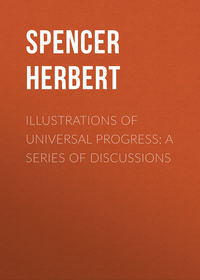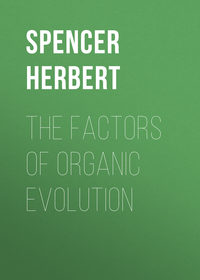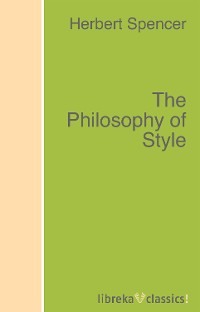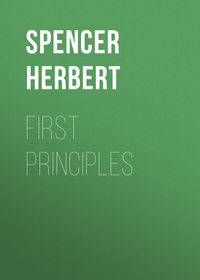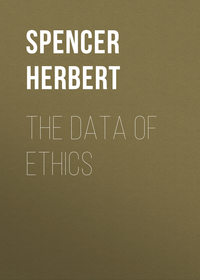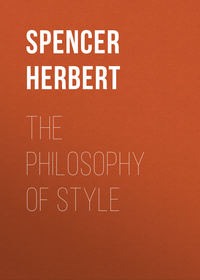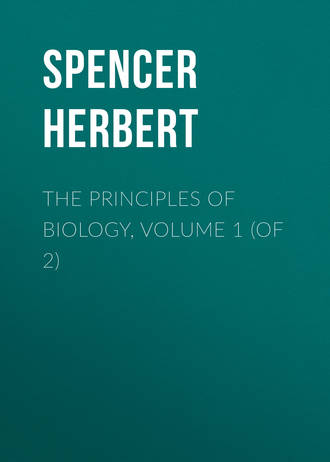 полная версия
полная версияThe Principles of Biology, Volume 1 (of 2)
"The first multicellular organism was probably a cluster of similar cells, but these units soon lost their original homogeneity. As the result of mere relative position, some of the cells were especially fitted to provide for the nutrition of the colony, while others undertook the work of reproduction." (Essays upon Heredity, i, p. 27)
Here, then, we have the great principle of the division of labour, which is the principle of all organization, taken as primarily illustrated in the division between the reproductive cells and the non-reproductive or somatic cells – the cells devoted to the continuance of the species, and the cells which subserve the life of the individual. And the early separation of reproductive cells from somatic cells, is alleged on the ground that this primary division of labour is that which arises between elements devoted to species-life and elements devoted to individual life. Let us not be content with words but look at the facts.
When Milne-Edwards first used the phrase "physiological division of labour," he was obviously led to do so by perceiving the analogy between the division of labour in a society, as described by political economists, and the division of labour in an organism. Every one who reads has been familiarized with the first as illustrated in the early stages, when men were warriors while the cultivation and drudgery were done by slaves and women; and as illustrated in the later stages, when not only are agriculture and manufactures carried on by separate classes, but agriculture is carried on by landlords, farmers, and labourers, while manufactures, multitudinous in their kinds, severally involve the actions of capitalists, overseers, workers, &c., and while the great function of distribution is carried on by wholesale and retail dealers in different commodities. Meanwhile students of biology, led by Milne-Edwards's phrase, have come to recognize a parallel arrangement in a living creature; shown, primarily, in the devoting of the outer parts to the general business of obtaining food and escaping from enemies, while the inner parts are devoted to the utilization of food, and supporting themselves and the outer parts; and shown, secondarily, by the subdivision of these great functions into those of various limbs and senses in the one case, and in the other case into those of organs for digestion, respiration, circulation, excretion, &c. But now let us ask what is the essential nature of this division of labour. In both cases it is an exchange of services– an arrangement under which, while one part devotes itself to one kind of action and yields benefits to all the rest, all the rest, jointly and severally performing their special actions, yield benefits to it in exchange. Otherwise described, it is a system of mutual dependence: A depends for its welfare upon B, C, and D; B upon A, C, and D; and so with the rest: all depend upon each and each upon all. Now let us apply this true conception of the division of labour, to that which Professor Weismann calls a division of labour. Where is the exchange of services between somatic cells and reproductive cells? There is none. The somatic cells render great services to the reproductive cells, by furnishing them with materials for growth and multiplication; but the reproductive cells render no services at all to the somatic cells. If we look for the mutual dependence we look in vain. We find entire dependence on the one side and none on the other. Between the parts devoted to individual life and the part devoted to species-life, there is no division of labour whatever. The individual works for the species; but the species works not for the individual. Whether at the stage when the species is represented by reproductive cells, or at the stage when it is represented by eggs, or at the stage when it is represented by young, the parent does everything for it, and it does nothing for the parent. The essential part of the conception is gone: there is no giving and receiving, no exchange, no mutuality.
But now suppose we pass over this fallacious interpretation, and grant Professor Weismann his fundamental assumption and his fundamental corollary. Suppose we grant that because the primary division of labour is that between somatic cells and reproductive cells, these two groups are the first to be differentiated. Having granted this corollary, let us compare it with the facts. As the alleged primary division of labour is universal, so the alleged primary differentiation should be universal too. Let us see whether it is so. Already, in the paragraph from which I have quoted above, a crack in the doctrine is admitted: it is said that "this differentiation was not at first absolute, and indeed it is not always so to-day." And then, on turning to page 74, we find that the crack has become a chasm. Of the reproductive cells it is stated that – "In Vertebrata they do not become distinct from the other cells of the body until the embryo is completely formed." That is to say, in this large and most important division of the animal kingdom, the implied universal law does not hold. Much more than this is confessed. Lower down the page we read – "There may be in fact cases in which such separation does not take place until after the animal is completely formed, and others, as I believe that I have shown, in which it first arises one or more generations later, viz., in the buds produced by the parent."
So that in other great divisions of the animal kingdom the alleged law is broken; as among the Cœlenterata by the Hydrozoa, as among the Mollusca by the Ascidians, and as among the Platyhelminthes by the Trematode worms.
Following this admission concerning the Vertebrata, come certain sentences which I partially italicize: —
"Thus, as their development shows, a marked antithesis exists between the substance of the undying reproductive cells and that of the perishable body-cells. We cannot explain this fact except by the supposition that each reproductive cell potentially contains two kinds of substance, which at a variable time after the commencement of embryonic development, separate from one another, and finally produce two sharply contrasted groups of cells." (p. 74)
And a little lower down the page we meet with the lines: —
"It is therefore quite conceivable that the reproductive cells might separate from the somatic cells much later than in the examples mentioned above, without changing the hereditary tendencies of which they are the bearers."
That is to say, it is "quite conceivable" that after sexless Cercariæ have gone on multiplying by internal gemmation for generations, the "two kinds of substance" have, notwithstanding innumerable cell-divisions, preserved their respective natures, and finally separate in such ways as to produce reproductive cells. Here Professor Weismann does not, as in a case before noted, assume something which it is "easy to imagine," but he assumes something which it is difficult to imagine; and apparently thinks that a scientific conclusion may be thereon safely based.
* * * * *Associated with the assertion that the primary division of labour is between the somatic cells and the reproductive cells, and associated with the corollary that the primary differentiation is that which arises between them, there goes another corollary. It is alleged that there exists a fundamental distinction of nature between these two classes of cells. They are described as respectively mortal and immortal, in the sense that those of the one class are limited in their powers of multiplication, while those of the other class are unlimited. And it is contended that this is due to inherent unlikeness of nature.
Before inquiring into the truth of this proposition, I may fitly remark upon a preliminary proposition set down by Professor Weismann. Referring to the hypothesis that death depends "upon causes which lie in the nature of life itself," he says: —
"I do not however believe in the validity of this explanation: I consider that death is not a primary necessity, but that it has been secondarily acquired as an adaptation. I believe that life is endowed with a fixed duration, not because it is contrary to its nature to be unlimited, but because the unlimited existence of individuals would be a luxury without any corresponding advantage." (p. 24)
This last sentence has a teleological sound which would be appropriate did it come from a theologian, but which seems strange as coming from a man of science. Assuming, however, that the implication was not intended, I go on to remark that Professor Weismann has apparently overlooked a universal law of evolution – not organic only, but inorganic and super-organic – which implies the necessity of death. The changes of every aggregate, no matter of what kind, inevitably end in a state of equilibrium. Suns and planets die, as well as organisms. The process of integration, which constitutes the fundamental trait of all evolution, continues until it has brought about a state which negatives further alterations, molar or molecular – a state of balance among the forces of the aggregate and the forces which oppose them.108 In so far, therefore, as Professor Weismann's conclusions imply the non-necessity of death, they cannot be sustained.
But now let us consider the above-described antithesis between the immortal Protozoa and the mortal Metazoa. An essential part of the theory is that the Protozoa can go on dividing and subdividing without limit, so long as the fit external conditions are maintained. But what is the evidence for this? Even by Professor Weismann's own admission there is no proof. On p. 285 he says: —
"I could only consent to adopt the hypothesis of rejuvenescence [achieved by conjugation], if it were rendered absolutely certain that reproduction by division could never under any circumstances persist indefinitely. But this cannot be proved with any greater certainty than the converse proposition, and hence, as far as direct proof is concerned, the facts are equally uncertain on both sides."
But this is an admission which seems to be entirely ignored when there is alleged the contrast between the immortal Protozoa and the mortal Metazoa. Following Professor Weismann's method, it would be "easy to imagine" that occasional conjugation is in all cases essential; and this easily imagined conclusion might fitly be used to bar out his own. Indeed, considering how commonly conjugation is observed, it may be held difficult to imagine that it can in any cases be dispensed with. Apart from imaginations of either kind, however, here is an acknowledgment that the immortality of Protozoa is not proved; that the allegation has no better basis than the failure to observe cessation of fission; and that thus one term of the above antithesis is not a fact, but is only an assumption.
And now what about the other term of the antithesis – the alleged inherent mortality of the somatic cells? This we shall, I think, find is no more defensible than the other. Such plausibility as it possesses disappears when, instead of contemplating the vast assemblage of familiar cases which animals present, we contemplate certain less familiar and unfamiliar cases. By these we are shown that the usual ending of multiplication among somatic cells is due, not to an intrinsic cause, but to extrinsic causes. Let us, however, first look at Professor Weismann's own statements: —
"I have endeavoured to explain death as the result of restriction in the powers of reproduction possessed by the somatic cells, and I have suggested that such restriction may conceivably follow from a limitation in the number of cell-generations possible for the cells of each organ and tissue." (p. 28)
"The above-mentioned considerations show us that the degree of reproductive activity present in the tissues is regulated by internal causes while the natural death of an organism is the termination – the hereditary limitation – of the process of cell-division, which began in the segmentation of the ovum." (p. 30)
Now, though, in the above extracts there is mention of "internal causes" determining "the degree of reproductive activity" of tissue cells, and though, on page 28, the "causes of the loss" of the power of unlimited cell-production "must be sought outside the organism, that is to say, in the external conditions of life," yet the doctrine is that somatic cells have become constitutionally unfitted for continued cell-multiplication.
"The somatic cells have lost this power to a gradually increasing extent, so that at length they became restricted to a fixed, though perhaps very large, number of cell-generations." (p. 28)
Examination will soon disclose good reasons for denying this inherent restriction. We will look at the various causes which affect their multiplication, and usually put a stop to increase after a certain point is reached.
There is first the amount of vital capital given by the parent; partly in the shape of a more or less developed structure, and partly in the shape of bequeathed nutriment. Where this vital capital is small, and the young creature, forthwith obliged to carry on physiological business for itself, has to expend effort in obtaining materials for daily consumption as well as for growth, a rigid restraint is put on that cell-multiplication required for a large size. Clearly, the young elephant, starting with a big and well-organized body, and supplied gratis with milk during early stages of growth, can begin physiological business on his own account on a great scale; and by its large transactions his system is enabled to supply nutriment to its multiplying somatic cells until they have formed a vast aggregate – an aggregate such as it is impossible for a young mouse to reach, obliged as it is to begin physiological business in a small way. Then there is the character of the food in respect of its digestibility and its nutritiveness. Here, that which the creature takes in requires much grinding-up, or, when duly prepared, contains but a small amount of available matter in comparison with the matter that has to be thrown away; while there, the prey seized is almost pure nutriment, and requires but little trituration. Hence, in some cases, an unprofitable physiological business, and in other cases a profitable one; resulting in small or large supplies to the multiplying somatic cells. Further, there has to be noted the grade of visceral development, which, if low, yields only crude nutriment slowly distributed, but which, if high, serves by its good appliances for solution, depuration, absorption, and circulation, to yield to the multiplying somatic cells a rich and pure blood. Then we come to an all-important factor, the cost of obtaining food. Here large expenditure of energy in locomotion is necessitated, and there but little – here great efforts for small portions of food, and there small efforts for great portions: again resulting in physiological poverty or physiological wealth. Next, beyond the cost of nervo-muscular activities in foraging, there is the cost of maintaining bodily heat. So much heat implies so much consumed nutriment, and the loss by radiation or conduction, which has perpetually to be made good, varies according to many circumstances – climate, medium (as air or water), covering, size of body (small cooling relatively faster than large); and in proportion to the cost of maintaining heat is the abstraction from the supplies for cell-formation. Finally, there are three all-important co-operative factors, or rather laws of factors, the effects of which vary with the size of the animal. The first is that, while the mass of the body varies as the cubes of its dimensions (proportions being supposed constant), the absorbing surface varies as the squares of its dimensions; whence it results that, other things equal, increase of size implies relative decrease of nutrition, and therefore increased obstacles to cell-multiplication.109 The second is a further sequence from these laws – namely, that while the weight of the body increases as the cubes of the dimensions, the sectional areas of its muscles and bones increase as their squares; whence follows a decreasing power of resisting strains, and a relative weakness of structure. This is implied in the ability of a small animal to leap many times its own length, while a great animal, like the elephant, cannot leap at all: its bones and muscles being unable to bear the stress which would be required to propel its body through the air. What increasing cost of keeping together the bodily fabric is thus entailed, we cannot say; but that there is an increasing cost, which diminishes the available, materials for increase of size, is beyond question.110 And then, in the third place, we have augmented expense of distribution of nutriment. The greater the size becomes, the more force must be exerted to send blood to the periphery; and this once more entails deduction from the cell-forming matters.
Here, then, we have nine factors, several of them involving subdivisions, which co-operate in aiding or restraining cell-multiplication. They occur in endlessly varied proportions and combinations; so that every species differs more or less from every other in respect of their effects. But in all of them the co-operation is such as eventually arrests that multiplication of cells which causes further growth; continues thereafter to entail slow decrease in cell-multiplication, accompanying decline of vital activities; and eventually brings cell-multiplication to an end. Now a recognized principle of reasoning – the Law of Parsimony – forbids the assumption of more causes than are needful for explanation of phenomena; and since, in all such living aggregates as those above supposed, the causes named inevitably bring about arrest of cell-multiplication, it is illegitimate to ascribe this arrest to some inherent property in the cells. Inadequacy of the other causes must be shown before an inherent property can be rightly assumed.
For this conclusion we find ample justification when we contemplate types of animals which lead lives that do not put such decided restraints on cell-multiplication. First let us take an instance of the extent to which (irrespective of natures of cells as reproductive or somatic) cell-multiplication may go, where the conditions render nutrition easy and reduce expenditure to a minimum. I refer to the case of the Aphides. Though it is early in the season (March), the hothouses at Kew have furnished a sufficient number of these to show that twelve of them weigh a grain – a larger number than would be required were they full-sized. Citing Professor Owen, who adopts the calculations of Tougard to the effect that by agamic multiplication "a single impregnated ovum of Aphis may give rise, without fecundation, to a quintillion of Aphides," Professor Huxley says: —
"I will assume that an Aphis weighs 1⁄1000 of a grain, which is certainly vastly under the mark. A quintillion of Aphides will, on this estimate, weigh a quatrillion of grains. He is a very stout man who weighs two million grains; consequently the tenth brood alone, if all its members survive the perils to which they are exposed, contains more substance than 500,000,000 stout men – to say the least, more than the whole population of China!"111
And had Professor Huxley taken the actual weight, one-twelfth of a grain, the quintillion of Aphides would evidently far outweigh the whole human population of the globe: five billions of tons being the weight, as brought out by my own calculation! Of course I do not cite this in proof of the extent to which multiplication of somatic cells, descending from a single ovum, may go; because it will be contended, with some reason, that each of the sexless Aphides, viviparously produced, arose by fission of a cell which had descended from the original reproductive cell. I cite it merely to show that when the cell-products of a fertilized ovum are perpetually divided and subdivided into small groups, distributed over an unlimited nutritive area, so that they can get materials for growth at no cost, and expend nothing appreciable in motion or maintenance of temperature, cell-production may go on without limit. For the agamic multiplication of Aphides has been shown to continue for four years, and to all appearance would be ceaseless were the temperature and supply of food continued without break. But now let us pass to analogous illustrations of cause and consequence, open to no criticism of the kind just indicated. They are furnished by various kinds of Entozoa, of which take the Trematoda, infesting molluscs and fishes. Of one of them we read: – "Gyrodactylus multiplies agamically by the development of a young Trematode within the body, as a sort of internal bud. A second generation appears within the first, and even a third within the second, before the young Gyrodactylus is born."112 And the drawings of Steenstrup, in his Alternation of Generations, show us, among creatures of this group, a sexless individual the whole interior of which is transformed into smaller sexless individuals, which severally, before or after their emergence, undergo similar transformations – a multiplication of somatic cells without any sign of reproductive cells. Under what circumstances do such modes of agamic multiplication, variously modified among parasites, occur? They occur where there is no expenditure whatever in motion or maintenance of temperature, and where nutriment surrounds the body on all sides. Other instances are furnished by groups in which, though the nutriment is not abundant, the cost of living is almost unappreciable. Among the Cœlenterata there are the Hydroid Polyps, simple and compound; and among the Mollusca we have various types of Ascidians, fixed and floating, Botryllidæ and Salpæ.
But now from these low animals in which sexless reproduction, and continued multiplication of somatic cells, is common, and one class of which is named "zoophytes," because its form of life simulates that of plants, let us pass to plants themselves. In these there is no expenditure in effort, there is no expenditure in maintaining temperature, and the food, some of it supplied by the earth, is the rest of it supplied by a medium which everywhere bathes the outer surface: the utilization of its contained material being effected gratis by the Sun's rays. Just as was to be expected, we here find that agamogenesis may go on without end. Numerous plants and trees are propagated to an unlimited extent by cuttings and buds; and we have sundry plants which cannot be otherwise propagated. The most familiar are the double roses of our gardens: these do not seed, and yet have been distributed everywhere by grafts and buds. Hothouses furnish many cases, as I learn from an authority second to none. Of "the whole host of tropical orchids, for instance, not one per cent. has ever seeded, and some have been a century under cultivation." Again, we have the Acorus calamus, "that has hardly been known to seed anywhere, though it is found wild all over the north temperate hemisphere." And then there is the conspicuous and conclusive case of Eloidea Canadensis (alias Anacharis,) introduced no one knows how (probably with timber), and first observed in 1847, in several places; and which, having since spread over nearly all England, now everywhere infests ponds, canals, and slow rivers. The plant is diœcious, and only the female exists here. Beyond all question, therefore, this vast progeny of the first slip or fragment introduced, sufficient to cover many square miles were it put together, is constituted entirely of somatic cells. Hence, as far as we can judge, these somatic cells are immortal in the sense given to the word by Professor Weismann; and the evidence that they are so is immeasurably stronger than the evidence which leads him to assert immortality for the fissiparously-multiplying Protozoa. This endless multiplication of somatic cells has been going on under the eyes of numerous observers for forty odd years. What observer has watched for forty years to see whether the fissiparous multiplication of Protozoa does not cease? What observer has watched for one year, or one month, or one week?113
Even were not Professor Weismann's theory disposed of by this evidence, it might be disposed of by a critical examination of his own evidence, using his own tests. Clearly, if we are to measure relative mortalities, we must assume the conditions to be the same and must use the same measure. Let us do this with some appropriate animal – say Man, as the most open to observation. The mortality of the somatic cells constituting the mass of the human body, is, according to Professor Weismann, shown by the decline and final cessation of cell-multiplication in its various organs. Suppose we apply this test to all the organs: not to those only in which there continually arise bile-cells, epithelium-cells, &c., but to those also in which there arise reproductive cells. What do we find? That the multiplication of these last comes to an end long before the multiplication of the first. In a healthy woman, the cells which constitute the various active tissues of the body, continue to grow and multiply for many years after germ-cells have died out. If similarly measured, then, these cells of the last class prove to be more mortal than those of the first. But Professor Weismann uses a different measure for the two classes of cells. Passing over the illegitimacy of this proceeding, let us accept his other mode of measurement, and see what comes of it. As described by him, absence of death among the Protozoa is implied by that unceasing division and subdivision of which they are said to be capable. Fission continued without end, is the definition of the immortality he speaks of. Apply this conception to the reproductive cells in a Metazoon. That the immense majority of them do not multiply without end, we have already seen: with very rare exceptions they die and disappear without result, and they cease their multiplication while the body as a whole still lives. But what of those extremely exceptional ones which, as being actually instrumental to the maintenance of the species, are alone contemplated by Professor Weismann? Do these continue their fissiparous multiplications without end? By no means. The condition under which alone they preserve a qualified form of existence, is that, instead of one becoming two, two become one. A member of series A and a member of series B, coalesce; and so lose their individualities. Now, obviously, if the immortality of a series is shown if its members divide and subdivide perpetually, then the opposite of immortality is shown when, instead of division, there is union. Each series ends, and there is initiated a new series, differing more or less from both. Thus the assertion that the reproductive cells are immortal, can be defended only by changing the conception of immortality otherwise implied.



